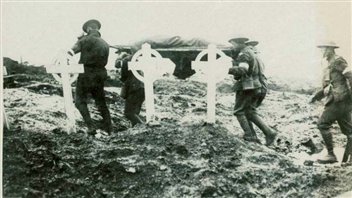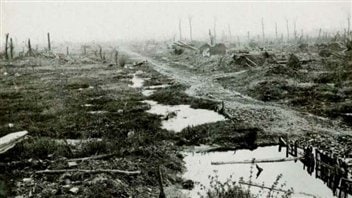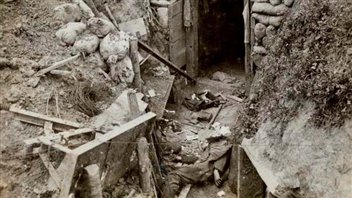As we approach the 100th anniversary of the start of the First World War there will be many stories written. Noted author and historian Tim Cook has just published a scholarly article on an eerie aspect of the war.
Going into the war, very very few on either side knew what they were getting in to. Fresh faced young men, were soon faced with filth and unimaginable destruction.

in surreal coexistence
© G Metcalf collection CWM 19930013-477
In an atmosphere of constant and instantaneous death, from unseen shell, or the bayonet of an enemy an arms reach away, of sleep deprivation, of fear, anger, sorrow, and resignation, it is not surprising that they saw ghosts, or apparitions, or were somehow saved from death by someone who couldn’t possibly be there.
Tim Cook’s article is called “Grave Beliefs: Stories of the Supernatural and the Uncanny among Canada’s Great War Trench Soldiers,” and appears in The Journal of Military History 77 #2 (April 2013): 521-542.
ListenThere are stories of semi-buried soldiers whose ghastly hand and arm protruded from the trench wall, and which was regularly shaken by others passing by. Other stories of whole trenches of soldiers buried alive by the dirt thrown up from a nearby shell explosion. Of the buried being blown up back to the surface, only to be reburied by other shells, or of friends simply disappearing in a fine red spray of mud and blood.

but four years later this picture of 1919 shows the
lingering intensity of the battle
© Metcalf collection CWM 19920044-938
“Along the road was an unburied hand of a soldier,” wrote Lieutenant Fred Wells. “Some of our ‘wags’ would pretend to shake hands with it—a bit of humour along the way.” Body parts protruding from the walls were touched for good luck; gas masks and helmets were hung from arms and legs. Such actions were shocking in their callousness, but they were one way to cope with living in the land of the dead. Familiarity bred contempt. “We are all used to dead bodies or pieces of men, so much so that we are not troubled by the sight of them,” wrote one Canadian. “There was a right hand sticking out of the trench in the position of a man trying to shake hands with you, and as the men filed out they would often grip it and say, ‘So long, old top, we’ll be back again soon.’” With the hollow-eyed and filthy soldiers looking like the living dead and living with the recently—and not so recently—killed, it is not surprising that trench soldiers developed a familiar acquaintance with the bodies of the unknown slain. (Grave Beliefs)
It was a surreal existence where life and death were gruesomely co-mingled at every instant.
Dealing with these horrors, it is no wonder that soldiers began to hope or fear an afterlife, and that they could or did see deathly spirits roaming the battlefields, or that they had clear premonitions of their own deaths.

to his dugout. While the entrance is intact, the sides
of the trench have collapsed. Common items such as an
entrenching tool, a water bottle, and ammunition pouches
lie scattered on the ground
© Metcalf collection CWM 19920044-195
In researching his story, Tim Cook researched hundreds of Canadian soldiers letters and other archival material, in which tales are told of such visions. Others tell of being physically led away by a dead comrade or family member in the night, only to find the place where they had been lying with fellow soldiers had been blown to bits by a shell.
In one story Cook recounts how ar Canadian soldier wrote to his mother that, “One night while carrying bombs, I had occasion to take cover when about twenty yards off I saw you looking towards me as plain as life.” Dumbstruck, he “crawled nearly to the place where your vision appeared” as a German shell slammed into the place he had just left behind.
“Had it not been for you, I certainly would have been reported ‘missing,’” the soldier wrote. “You’ll turn up again, won’t you, mother, next time a shell is coming?”
In other cases, an other-worldly presence seemed to momentarily silence a raging battle to allow an escape.
Living soldiers became martyred corpses in the blink of an eye. The blurring of living and dead only added to the apocalyptic landscape. Moreover, grimy, exhausted soldiers, covered in mud, asleep on a fire step or in a funk hole could easily be mistaken for the dead. It was not lost on the soldiers that they seemed to be digging extended graves—the trenches—to protect themselves from death-dealing artillery shells. And, in sick irony, the artillery bombardments often buried the living and disgorged the dead. (Grave Beliefs)
Cook noted that even years after the war, soldiers did not change their stories, or indicate that what they saw was due to fatigue, stress, hunger, or thirst.
The award-winning author notes that he would like other historians to examine this subject in dealing with other wars and other militaries.







For reasons beyond our control, and for an undetermined period of time, our comment section is now closed. However, our social networks remain open to your contributions.